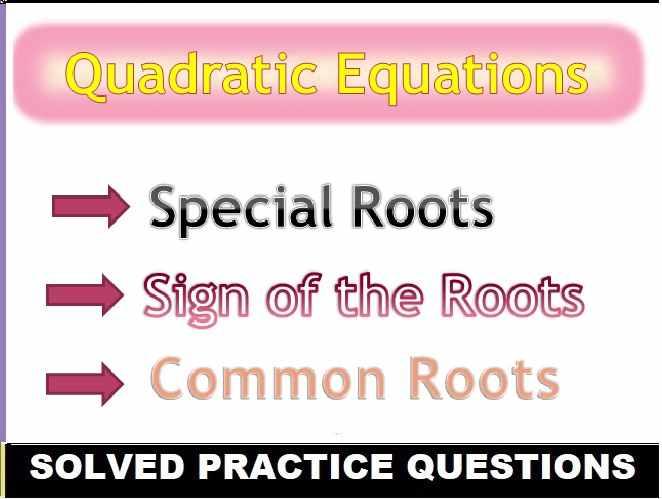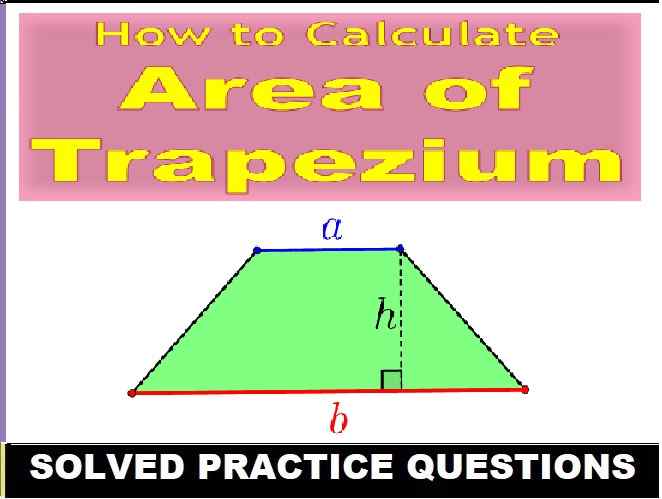ML Aggarwal Similarity Exe-13.3 Class 10 ICSE Maths Solutions. We Provide Step by Step Answer of Exe-13.3 Questions for Similarity as council prescribe guideline for upcoming board exam. Visit official Website CISCE for detail information about ICSE Board Class-10.
ML Aggarwal Similarity Exe-13.3 Class 10 ICSE Maths Solutions
| Board | ICSE |
| Subject | Maths |
| Class | 10th |
| Chapter-13 | Similarity |
| Writer / Book | Understanding |
| Topics | Solutions of Exe-13.3 |
| Academic Session | 2024-2025 |
Similarity Exe-13.3
ML Aggarwal Class 10 ICSE Maths Solutions
Question 1
Given that ∆s ABC and PQR are similar. Find :
(i) The ratio of the area of ∆ABC to the area of ∆PQR if their corresponding sides are in the ratio 1 : 3.
(ii) the ratio of their corresponding sides if area of ∆ABC : area of ∆PQR = 25 : 36.
Answer 1
From the question it is given that,
(i) The area of ∆ABC to the area of ∆PQR if their corresponding sides are in the ratio 1 : 3
Then, ∆ABC ~ ∆PQR
area of ∆ABC/area of ∆PQR = BC2/QR2
BC : QR = 1 : 3
Hence, ∆ABC/area of ∆PQR = 12/32
= 1/9
Hence the ratio of the area of ∆ABC to the area of ∆PQR is 1: 9
(ii) The area of ∆ABC to the area of ∆PQR if their corresponding sides are in the ratio 25 : 36
Then, ∆ABC ~ ∆PQR
area of ∆ABC/area of ∆PQR = BC2/QR2
area of ∆ABC/area of ∆PQR = BC2/QR2 = 25/36
= (BC/QR)2 = (5/6)2
BC/QR = 5/6
Hence the ratio of their corresponding sides is 5 : 6
Question 2
∆ABC ~ DEF. If area of ∆ABC = 9 sq. cm., area of ∆DEF =16 sq. cm and BC = 2.1 cm., find the length of EF.
Answer 2
Let EF = x
Given that
∆ABC ~ ∆DEF,
Area of ∆ABC = 9 sq. cm
Area of ∆DEF =16 sq. cm
area of ∆ABC/area of ∆DEF = BC2/EF2
area of ∆ABC/area of ∆DEF = BC2/EF2
9/16 = BC2/EF2
9/16 = (2.1)2/x2
2.1/x = √9/√16
2.1/x = ¾
By cross multiplication we get,
2.1 × 4 = 3 × x
8.4 = 3x
x = 8.4/3
x = 2.8
Hence, EF = 2.8 cm
Question 3
∆ABC ~ ∆DEF. If BC = 3 cm, EF = 4 cm and area of ∆ABC = 54 sq. cm. Determine the area of ∆DEF.
Answer 3
∆ABC ~ ∆DEF
BC = 3 cm, EF = 4 cm
Area of ∆ABC = 54 sq. cm.
We know that,
Area of ∆ABC/ area of ∆DEF = BC2/EF2
54/area of ∆DEF = 32/42
54/area of ∆DEF = 9/16
By cross multiplication we get,
Area of ∆DEF = (54 × 16)/9
= 6 × 16
= 96 cm
Question 4
The area of two similar triangles are 36 cm² and 25 cm². If an altitude of the first triangle is 2.4 cm, find the corresponding altitude of the other triangle.
Answer 4
The area of two similar triangles are 36 cm² and 25 cm².
Let us assume ∆PQR ~ ∆XYZ, PM and XN are their altitudes.
So, area of ∆PQR = 36 cm2
Area of ∆XYZ = 25 cm2
PM = 2.4 cm
Assume XN = a
area of ∆PQR/area of ∆XYZ = PM2/XN2
36/25 = (2.4)2/a2
By cross multiplication we get,
36a2 = 25 (2.4)2
a2 = 5.76 × 25/36
a2 = 144/36
a2 = 4
a = √4
a = 2 cm
Hence, altitude of the other triangle XN = 2 cm.
Question 5
(a) In the figure, (i) given below, PB and QA are perpendiculars to the line segment AB. If PO = 6 cm, QO = 9 cm and the area of ∆POB = 120 cm², find the area of ∆QOA. (2006)
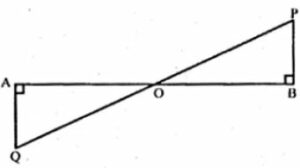
(b) In the figure (ii) given below, AB || DC. AO = 10 cm, OC = 5cm, AB = 6.5 cm and OD = 2.8 cm.
(i) Prove that ∆OAB ~ ∆OCD.
(ii) Find CD and OB.
(iii) Find the ratio of areas of ∆OAB and ∆OCD.
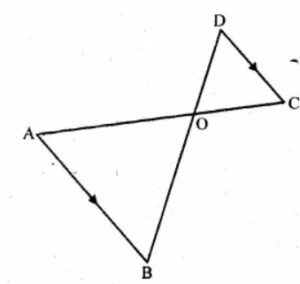
Answer 5
(a) From the question, PO = 6 cm, QO = 9 cm and the area of ∆POB = 120 cm²
Consider the ∆AOQ and ∆BOP,
∠OAQ = ∠OBP … [both angles are equal to 90o]
∠AOQ = ∠BOP … [because vertically opposite angles are equal]
Hence, ∆AOQ ~ ∆BOP
area of ∆AOQ/area of ∆BOP = OQ2/PO2
Area of ∆AOQ/120 = 92/62
Area of ∆AOQ/120 = 81/36
Area of ∆AOQ = (81 × 120)/36
Area of ∆AOQ = 270 cm2
(b) From the question
AB || DC. AO = 10 cm, OC = 5cm, AB = 6.5 cm and OD = 2.8 cm
(i) We have to prove that, ∆OAB ~ ∆OCD
consider the ∆OAB and ∆OCD
∠AOB = ∠COD … [because vertically opposite angles are equal]
∠OBA = ∠OCD … [because alternate angles are equal]
Hence, ∆OAB ~ ∆OCD … [from AAA axiom]
(ii) Consider the ∆OAB and ∆OCD
OA/OC = OB/OD = AB/CD
Now consider OA/OC = OB/OD
10/5 = OB/2.8
OB = (10 × 2.8)/5
OB = 2 × 2.8
OB = 5.6 cm
Then, consider OA/OC = AB/CD
10/5 = 6.5/CD
CD = (6.5 × 5)/10
CD = 32.5/10
CD = 3.25 cm
(iii) We have to find the ratio of areas of ∆OAB and ∆OCD.
From (i) we proved that, ∆OAB ~ ∆OCD
Then, area of (∆OAB)/area of ∆OCD
AB2/CD2 = (6.5)2/(3.25)2
= (6.5 × 6.5)/(3.25 × 3.25)
= 2 × 2/1
= 4/1
Hence, the ratio of areas of ∆OAB and ∆OCD = 4: 1.
ML Aggarwal Similarity Exe-13.3 Class 10 ICSE Maths Solutions
Page 287
Question 6
(a) In the figure (i) given below, DE || BC. If DE = 6 cm, BC = 9 cm and area of ∆ADE = 28 sq. cm, find the area of ∆ABC.
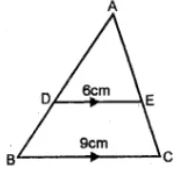
(b) In the figure (iii) given below, DE || BC and AD : DB = 1 : 2, find the ratio of the areas of ∆ADE and trapezium DBCE.

Answer 6
(a) In the figure,
DE || BC
∠D = ∠B and ∠E = ∠C
(Corresponding angles)
Now consider the ∆ADE and ∆ABC,
∠A = ∠A … [common angles for both triangles]
Hence, ∆ADE ~ ∆ABC
Then, area of ∆ADE/area of ∆ABC = (DE)2/(BC)2
28/area of ∆ABC = (6)2/(9)2
28/area of ∆ABC = 36/81
area of ∆ABC = (28 × 81)/36
area of ∆ABC = 2268/36
area of ∆ABC = 63 cm2
(b)
From the question,
DE || BC and AD : DB = 1 : 2,
∠D = ∠B, ∠E = ∠C … [corresponding angles are equal]
Consider the ∆ADE and ∆ABC,
∠A = ∠A … [common angles for both triangles]
Hence, ∆ADE ~ ∆ABC
But, AD/DB = ½
Then, DB/AD = 2/1
Now, adding 1 for both side LHS and RHS,
(DB/AD) + 1 = (2/1) + 1
(DB + AD)/AD = (2 + 1)
Therefore, ∆ADE ~ ∆ABC
Then, area of ∆ADE/area of ∆ABC = AD2/AB2
Area of ∆ADE/area of ∆ABC = (1/3)2
Area of ∆ADE/area of ∆ABC = 1/9
Area of ∆ABC = 9 area of ∆ADE
Area of trapezium DBCE
Area of ∆ABC – area of ∆ADE
9 area of ∆ADE – area of ∆ADE
8 area of ∆ADE
Therefore, area of ∆ADE/area of trapezium = 1/8
Then area of ∆ADE : area of trapezium DBCE = 1: 8
Question 7 In the given figure, DE || BC.
(i) Prove that ∆ADE and ∆ABC are similar.
(ii) Given that AD = 1/2 BD, calculate DE if BC = 4.5 cm.
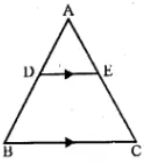
(iii) If area of ∆ABC = 18cm², find the area of trapezium DBCE
Answer 7
(i) From the question it is given that, DE || BC
We have to prove that, ∆ADE and ∆ABC are similar
∠A = ∠A … [common angle for both triangles]
∠ADE = ∠ABC … [because corresponding angles are equal]
Hence, ∆ADE ~ ∆ABC … [AA axiom]
(ii) From (i) we proved that, ∆ADE ~ ∆ABC
Then, AD/AB = AB/AC = DE/BC
So, AD/(AD + BD) = DE/BC
(½ BD)/ ((½BD) + BD) = DE/4.5
(½ BD)/ ((3/2)BD) = DE/4.5
½ × (2/3) = DE/4.5
1/3 = DE/4.5
Hence, DE = 4.5/3
DE = 1.5 cm
(iii) From the question it is given that, area of ∆ABC = 18 cm2
Then, area of ∆ADE/area of ∆ABC = DE2/BC2
area of ∆ADE/18 = (DE/BC)2
area of ∆ADE/18 = (AD/AB)2
area of ∆ADE/18 = (1/3)2 = 1/9
area of ∆ADE = 18 × 1/9
area of ∆ADE = 2
area of trapezium DBCE = area of ∆ABC – area of ∆ADE
= 18 – 2
= 16 cm2
Question 8 In the given figure, AB and DE are perpendicular to BC.
(i) Prove that ∆ABC ~ ∆DEC
(ii) If AB = 6 cm: DE = 4 cm and AC = 15 cm, calculate CD.
(iii) Find the ratio of the area of ∆ABC : area of ∆DEC.
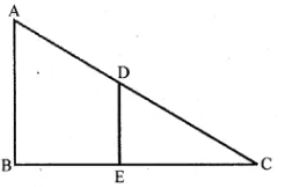
Answer 8
(i) Consider the ∆ABC and ∆DEC,
∠ABC = ∠DEC … [both angles are equal to 90o]
∠C = ∠C … [common angle for both triangles]
Hence, ∆ABC ~ ∆DEC … [by AA axiom]
(ii) AC/CD = AB/DE
Corresponding sides of similar triangles are proportional
15/CD = 6/4
CD = (15 × 4)/6
CD = 60/6
CD = 10 cm
(iii) area of ∆ABC/area of ∆DEC = AB2/DE2
area of ∆ABC/area of ∆DEC = 62/42
area of ∆ABC/area of ∆DEC = 36/16
area of ∆ABC/area of ∆DEC = 9/4
Hence, the ratio of the area of ∆ABC : area of ∆DEC is 9 : 4.
Question 9 In the adjoining figure, ABC is a triangle.
DE is parallel to BC and AD/DB=3/2
(i) Determine the ratios AD/AB,DE/BC
(ii) Prove that ∆DEF is similar to ∆CBF.
Hence, find EF/FB.
(iii) What is the ratio of the areas of ∆DEF and ∆CBF ? (2007)
Ans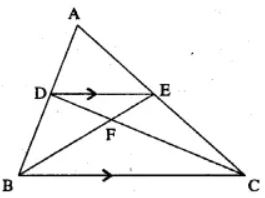 wer 9
wer 9
(i) We have to find the ratios AD/AB, DE/BC,
From the question
AD/DB = 3/2
Then, DB/AD = 2/3
Now add 1 for both LHS and RHS we get,
(DB/AD) + 1 = (2/3) + 1
(DB + AD)/AD = (2 + 3)/3
From the figure (DB + AD) = AB
So, AB/AD = 5/3
Now, consider the ∆ADE and ∆ABC,
∠ADE = ∠B … [corresponding angles are equal]
∠AED = ∠C … [corresponding angles are equal]
Hence, ∆ADE ~ ∆ABC … [by AA similarity]
Then, AD/AB = DE/BC = 3/5
(ii) Now consider the ∆DEF and ∆CBF
∠EDF = ∠BCF … [because alternate angles are equal]
∠DEF = ∠FBC … [because alternate angles are equal]
∠DFE = ∠ABFC … [because vertically opposite angles are equal]
Hence, ∆DEF ~ ∆CBF
So, EF/FB = DE/BC = 3/5
(iii) we have to find the ratio of the areas of ∆DEF and ∆CBF,
We know that, Area of ∆DFE/Area of ∆BFC = DE2/BC2
Area of ∆DFE/Area of ∆BFC = (DE/BC)2
Area of ∆DFE/Area of ∆BFC = (3/5)2
Area of ∆DFE/Area of ∆BFC = 9/25
Hence, the ratio of the areas of ∆DEF and ∆CBF is 9: 25.
Page 288
Question 10
In ∆PQR, MN is parallel to QR and PM/MQ = 2/3
(i) Find MN/QR
(ii) Prove that ∆OMN and ∆PRQ are similar
(iii) Find area of ∆OMN : area of ∆ORQ
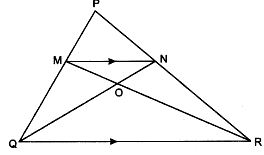
Answer 10
(i) In ΔPMN and ΔPQR, MN || QR
⇒∠PMN=∠PQR (alternate angles)
⇒∠PNM=∠PRQ (alternate angles)
=> ΔPMN ~ ΔPQR (AA postulate)

(ii) In ΔOMN and ΔORQ,
∠OMN=∠ORQ (alternate angles)
∠MNO=∠OQR (alternate angles)
=> ΔOMN ~ ΔORQ (AA postulate)
(iii)

ML Aggarwal Similarity Exe-13.3 Class 10 ICSE Maths Solutions
Question 11
In ∆ABC, AP : PB = 2 : 3. PO is parallel to BC and is extended to Q so that CQ is parallel to BA. Find:
(i) Area ∆APO : area ∆ABC.
(ii) Area ∆APO : area ∆CQO. (2008)
Answ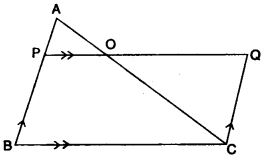 er 11 :
er 11 :
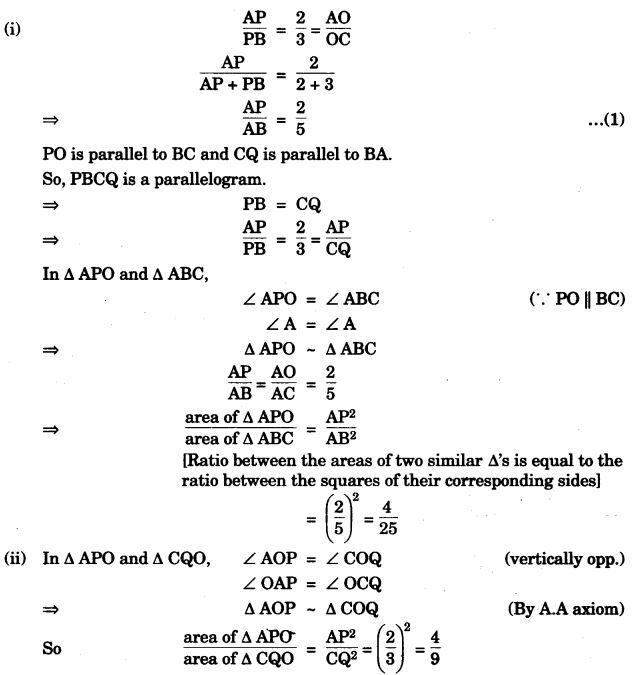
Question 12
(a) In the figure (i) given below, ABCD is a trapezium in which AB || DC and AB = 2 CD. Determine the ratio of the areas of ∆AOB and ∆COD.
(b) In the figure (ii) given below, ABCD is a parallelogram. AM ⊥ DC and AN ⊥ CB. If AM = 6 cm, AN = 10 cm and the area of parallelogram ABCD is 45 cm², find
(i) AB
(ii) BC
(iii) area of ∆ADM : area of ∆ANB.
(c) In the figure (iii) given below, ABCD is a parallelogram. E is a point on AB, CE intersects the diagonal BD at O and EF || BC. If AE : EB = 2 : 3, find
(i) EF : AD
(ii) area of ∆BEF : area of ∆ABD
(iii) area of ∆ABD : area of trap. AFED
(iv) area of ∆FEO : area of ∆OBC.
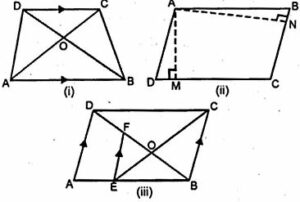
Answer 12
(a) In trapezium ABCD, AB || DC.
∠OAB = ∠OCD [alternate angles] ∠OBA = ∠ODC
∆AOB ~ ∆COD
So, area of ∆AOB/area of ∆COD = AB2/CD2
= (2CD)2/CD2 … [because AB = 2 CD]
= 4CD2/CD2
= 4/1
Hence, the ratio of the areas of ∆AOB and ∆COD is 4: 1.
(b) From the question it is given that,
ABCD is a parallelogram, AM ⊥ DC and AN ⊥ CB
AM = 6 cm
AN = 10 cm
The area of parallelogram ABCD is 45 cm²
Then, area of parallelogram ABCD = DC × AM = BC × AN
45 = DC × 6 = BC × 10
(i) DC = 45/6
Divide both numerator and denominator by 3 we get,
= 15/2
= 7.5 cm
Hence, AB = DC = 7.5 cm
(ii) BC × 10 = 45
BC = 45/10
BC = 4.5 cm
(iii) Now, consider ∆ADM and ∆ABN
∠D = ∠B … [because opposite angles of a parallelogram]
∠M = ∠N … [both angles are equal to 90o]
Hence, ∆ADM ~ ∆ABN
Therefore, area of ∆ADM/area of ∆ABN = AD2/AB2
= BC2/AB2
= 4.52/7.52
= 20.25/56.25
= 2025/5625
= 81/225
= 9/25
Hence, area of ∆ADM : area of ∆ANB is 9: 25
(c) From the question it is given that, ABCD is a parallelogram.
E is a point on AB, CE intersects the diagonal BD at O.
AE : EB = 2 : 3
(i) find EF : AD
So, AB/BE = AD/EF
EF/AD = BE/AB
AE/EB = 2/3 … [given]
Now add 1 to both LHS and RHS we get,
(AE/EB) + 1 = (2/3) + 1
(AE + EB)/EB = (2 + 3)/3
AB/EB = 5/3
EB/AB = 3/5
EF : AD is 3: 5
(ii) we have to find area of ∆BEF: area of ∆ABD,
Then, area of ∆BEF/area of ∆ABD = (EF)2/(AD)2
area of ∆BEF/area of ∆ABD = 32/52
= 9/25
area of ∆BEF: area of ∆ABD is 9: 25
(iii) From (ii) area of ∆ABD/area of ∆BEF = 25/9
25 area of ∆BEF = 9 area of ∆ABD
25(area of ∆ABD – area of trapezium AEFD) = 9 area of ∆ABD
25 area of ∆ABD – 25 area of trapezium AEFD = 9 area of ∆ABD
25 area of trapezium AEFD = 25 area of ∆ABD – 9 area of ∆ABD
25 area of trapezium AEFD = 16 area of ∆ABD
area of ∆ABD/area of trapezium AEFD = 25/16
Therefore, area of ∆ABD : area of trapezium AFED = 25: 16
(iv) Now we have to find area of ∆FEO : area of ∆OBC
consider ∆FEO and ∆OBC,
∠EOF = ∠BOC … [because vertically opposite angles are equal]
∠F = ∠OBC … [because alternate angles are equal]
∆FEO ~ ∆OBC
Then, area of FEO/area of ∆OBC = EF2/BC2
EF2/AD2 = 9/25
Hence, area of ∆FEO: area of ∆OBC = 9: 25.
Question 13 In the adjoining figure, ABCD is a parallelogram. P is a point on BC such that BP : PC = 1 : 2 and DP produced meets AB produced at Q. If area of ∆CPQ = 20 cm², find
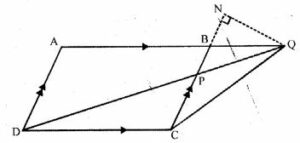
(i) area of ∆BPQ.
(ii) area ∆CDP.
(iii) area of || gm ABCD.
Answer 13
In the figure, ABCD is a parallelogram.
P is a point on BC such that BP : PC = 1 : 2
and DP is produced to meet ABC produced at Q.
Area ∆CPQ = 20 cm²

Then, area of ∆BPQ/area of ∆CPQ = ((½BP) × QN)/((½PC) × QN)
= BP/PC = ½
(i) So, area ∆BPQ = ½ area of ∆CPQ
= ½ × 20
area of ∆BPQ = 10 cm2
(ii) Now we have to find area of ∆CDP,
Consider the ∆CDP and ∆BQP,
Then, ∠CPD = ∠QPD … [because vertically opposite angles are equal]
∠PDC = ∠PQB … [because alternate angles are equal]
∆CDP ~ ∆BQP … [AA axiom]
area of ∆CDP/area of ∆BQP = PC2/BP2
area of ∆CDP/area of ∆BQP = 22/12
area of ∆CDP/area of ∆BQP = 4/1
area of ∆CDP = 4 × area ∆BQP
area of ∆CDP = 4 × 10
= 40 cm2
(iii) We have to find the area of parallelogram ABCD,
Area of parallelogram ABCD = 2 area of ∆DCQ
= 2 area (∆DCP + ∆CPQ)
= 2 (40 + 20) cm2
= 2 × 60 cm2
= 120 cm2
Hence, the area of parallelogram ABCD is 120 cm2.
Similarity Exe-13.3
ML Aggarwal Class 10 ICSE Maths Solutions
Page 289
Question 14
(a) In the figure (i) given below, DE || BC and the ratio of the areas of ∆ADE and trapezium DBCE is 4 : 5. Find the ratio of DE : BC.

(b) In the figure (ii) given below, AB || DC and AB = 2 DC. If AD = 3 cm, BC = 4 cm and AD, BC produced meet at E, find (i) ED (ii) BE (iii) area of ∆EDC : area of trapezium ABCD.
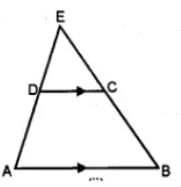
Answer 14
(a) In ∆ABC, DE || BC
Now in ∆ABC and ∆ADE
∠A = ∠A (common)
∠D = ∠B and ∠E = ∠C
(Corresponding angles)
∆ADE ~ ∆ABC
So, area of ∆ADE/area of ∆ABC = (DE)2/(BC)2 … [equation (i)]
Then, area of ∆ADE/area of trapezium DBCE = 4/5
area of trapezium DBCE/area of ∆ADE = 5/4
Add 1 for both LHS and RHS we get,
(area of trapezium DBCE/area of ∆ADE) + 1 = (5/4) + 1
(area of trapezium DBCE + area of ∆ADE)/area of ∆ADE = (5 + 4)/4
area of ∆ABC/area of ∆ADE = 9/4
area of ∆ADE/area of ∆ABC = 4/9
From equation (i),
area of ∆ADE/area of ∆ABC = (DE)2/(BC)2
area of ∆ADE/area of ∆ABC = (DE)2/(BC)2 = 42/92
area of ∆ADE/area of ∆ABC = (DE)2/(BC)2 = 2/3
Hence, DE: BC = 2: 3
(b) AB || DC
AB = 2 DC, AD = 3 cm, BC = 4 cm
Now consider ∆EAB,
EA/DA = EB/CB = AB/DC = 2DC/DC = 2/1
(i) EA = 2, DA = 2 × 3 = 6 cm
Then, ED = EA – DA
= 6 – 3
= 3 cm
(ii) EB/CB = 2/1
EB = 2 CB
EB = 2 × 4
EB = 8 cm
(iii) Now, consider the ∆EAB, DC || AB
So, ∆EDC ~ ∆EAB
Therefore, area of ∆EDC/area of ∆ABE = DC2/AB2
area of ∆EDC/area of ∆ABE = DC2/(2DC)2
area of ∆EDC/area of ∆ABE = DC2/4DC2
area of ∆EDC/area of ∆ABE = ¼
Therefore, area of ABE = 4 area of ∆EDC
Then, area of ∆EDC + area of trapezium ABCD = 4 area of ∆EDC
Area of trapezium ABCD = 3 area of ∆EDC
So, area of ∆EDC/area of trapezium ABCD = 1/3
Hence, area of ∆EDC: area of trapezium ABCD = 1: 3
Question 15
(a) In the figure given below, ABCD is a trapezium in which DC is parallel to AB. If AB = 9 cm, DC = 6 cm and BB = 12 cm., find
(i) BP
(ii) the ratio of areas of ∆APB and ∆DPC.
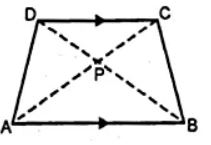
(b) In the figure given below, ∠ABC = ∠DAC and AB = 8 cm, AC = 4 cm, AD = 5 cm.
(i) Prove that ∆ACD is similar to ∆BCA
(ii) Find BC and CD
(iii) Find the area of ∆ACD : area of ∆ABC.

Answer 15
(a) In trapezium ABCD, DC || AB
AB = 9 cm, DC = 6 cm and BB = 12 cm
(i) Consider the ∆APB and ∆CPD
∠APB = ∠CPD … [because vertically opposite angles are equal]
∠PAB = ∠PCD … [because alternate angles are equal]
So, ∆APB ~ ∆CPD
Then, BP/PD = AB/CD
BP/(12 – BP) = 9/6
6BP = 108 – 9BP
6BP + 9BP = 108
15BP = 108
BP = 108/15
BP = 7.2 cm
(ii) area of ∆APB/area of ∆CPD = AB2/CD2
area of ∆APB/area of ∆CPD = 92/62
area of ∆APB/area of ∆CPD = 81/36
By dividing both numerator and denominator by 9, we get,
area of ∆APB/area of ∆CPD = 9/4
Hence, the ratio of areas of ∆APB and ∆DPC is 9: 4
(b) From the question it is given that,
∠ABC = ∠DAC
AB = 8 cm, AC = 4 cm, AD = 5 cm
(i) Now, consider ∆ACD and ∆BCA
∠C = ∠C … [common angle for both triangles]
∠ABC = ∠CAD … [from the question]
So, ∆ACD ~ ∆BCA … [by AA axiom]
(ii) AC/BC = CD/CA = AD/AB
Consider AC/BC = AD/AB
4/BC = 5/8
BC = (4 × 8)/5
BC = 32/5
BC = 6.4 cm
consider CD/CA = AD/AB
CD/4 = 5/8
CD = (4 × 5)/8
CD = 20/8
CD = 2.5 cm
(iii) from (i) we proved that, ∆ACD ~ ∆BCA
area of ∆ACB/area of ∆BCA = AC2/AB2
= 42/82
= 16/64
By dividing both numerator and denominator by 16, we get,
= ¼
Hence, the area of ∆ACD : area of ∆ABC is 1: 4.
Question 16
(a) In the given figure, ∠PQR = ∠PST = 90°, PQ = 5 cm and PS = 2 cm.
(i) Prove that △PQR ∼ APST.
(ii) Find Area of △PQR : Area of quadrilateral SRQT.
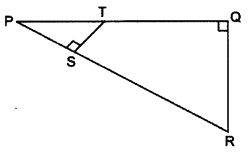
Answer 16
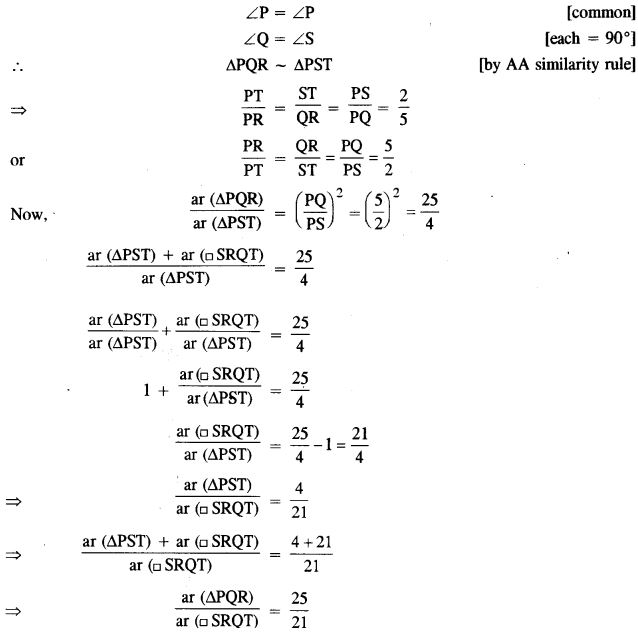
Question 17 ABC is a right angled triangle with ∠ABC = 90°. D is any point on AB and DE is perpendicular to AC. Prove that:
(i) ∆ADE ~ ∆ACB.
(ii) If AC = 13 cm, BC = 5 cm and AE = 4 cm. Find DE and AD.
(iii) Find, area of ∆ADE : area of quadrilateral BCED.
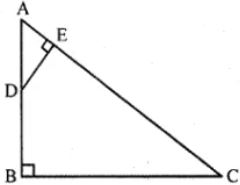
Answer 17
(i) Consider DADE and DACB
∠A = ∠A (Common)
m ∠B = m ∠E = 90°
Thus by angle-angle similarity, triangles,
∆ACB ~ ∆ADE
(ii) Consider ∆ADE and ∆ACB
Since they are similar triangles,
So, AE/AB = AD/AC = DE/BC … [equation (i)]
Consider the ∆ABC, is a right angle triangle
AC2 = AB2 + BC2
132 = AB2 + 52
169 = AB2 + 25
AB2 = 169 – 25
AB2 = 144
AB = √144
AB = 12 cm
Consider the equation (i),
AE/AB = AD/AC = DE/BC
Take, AE/AB = AD/AC
4/12 = AD/13
1/3 = AD/13
(1 × 13)/3 = AD
AD = 4.33 cm
Now, take AE/AB = DE/BC
4/12 = DE/5
1/3 = DE/5
DE = (5 × 1)/3
DE = 5/3
DE = 1.67 cm
(iii) Now, we have to find area of ∆ADE : area of quadrilateral BCED,
Area of ∆ADE = ½ × AE × DE
= ½ × 4 × (5/3)
= 10/3 cm2
Then, area of quadrilateral BCED = area of ∆ABC – area of ∆ADE
= ½ × BC × AB – 10/3
= ½ × 5 × 12 – 10/3
= 1 × 5 × 6 – 10/3
= 30 – 10/3
= (90 – 10)/3
= 80/3 cm2
So, the ratio of area of ∆ADE : area of quadrilateral BCED = (10/3)/(80/3)
= (10/3) × (3/80)
= (10 × 3)/(3 × 80)
= (1 × 1)/(1 × 8)
= 1/8
Hence, area of ∆ADE : area of quadrilateral BCED is 1: 8.
ML Aggarwal Class 10 ICSE Maths Solutions
Similarity Exe-13.3
Page 289
Question 18 Two isosceles triangles have equal vertical angles and their areas are in the ratio 7 : 16. Find the ratio of their corresponding height.
Answer 18
In two isosceles ∆s ABC and DEF
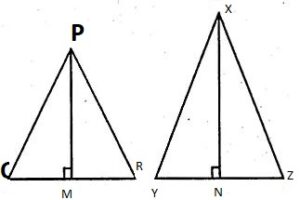
∠P = ∠X … [from the question]
So, ∠Q + ∠R = ∠Y + ∠Z
∠Q = ∠R and ∠Y = ∠Z [because opposite angles of equal sides]
Hence, ∠Q = ∠Y and ∠R = ∠Z
∆PQR ~ ∆XYZ
Then, area of ∆PQR/area of ∆XYZ = PM2/XN2 … [from corollary of theorem]
PM2/XN2 = 7/16
PM/XN = √7/√16
PM/XN = √7/4
ratio of PM: DM = √7: 4
Question 19 On a map drawn to a scale of 1 : 250000, a triangular plot of land has the following measurements :
AB = 3 cm, BC = 4 cm and ∠ABC = 90°. Calculate
(i) the actual length of AB in km.
(ii) the area of the plot in sq. km:
Answer 19
Scale factor k = 1 : 250000 = 1/250000
Length on map,
AB = 3 cm, BC = 4 cm
(i) We have to find the actual length of AB in km.
Let us assume scale factor K = 1: 250000
K = 1/250000
Then, length of AB of actual plot = 1/k × length of AB on the map
= (1/(1/250000)) × 3
= 250000 × 3
To covert cm into km divide by 100000
= (250000 × 3)/(100 × 1000)
= 15/2
length of AB of actual plot = 7.5 km
(ii) We have to find the area of the plot in sq. km
Area of plot on the map = ½ × AB × BC
= ½ × 3 × 4
= ½ × 12
= 1 × 6
= 6 cm2
Then, area of actual plot = 1/k2 × 6 cm2
= 2500002 × 6
To covert cm into km divide by (100000)2
= (250000 × 250000 × 6)/(100000 × 100000)
= (25/4) × 6
= 75/2
= 37.5 km2
Question 20 On a map drawn to a scale of 1 : 50,000, a rectangular plot of land ABCD has the following dimensions AB = 6 cm; BC = 8 cm and all angles are right angles. Find :
(i) the actual length of the diagonal distance AC of the plot in km.
(ii) the actual area of the plot in sq. km.
Answer 20
Scale used on the map is 1 : 50,000
Dimensions of a rectangular plot ABCD are AB = 6 cm, BC = 8 cm Since each angle is right angle
∴ By using Pythagoras theorem, we have
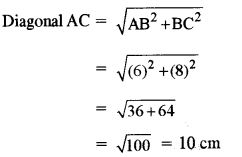
(i) Actual length of the diagonal AC = 10 × 50000 cm
= (500000/100000) km
= 5 km
(ii) Area of the rectangular field ABCD on map
= 6 × 8 = 48 cm2
Actual area of the field = 48 × 500000 × 500000
= 12(10)10 sq. cm.
= 12 sq. km.
Question 21 A map of a square plot of land is drawn to a scale 1 : 25000. If the area of the plot in the map is 72 cm², find:
(i) the actual area of the plot of the land
(ii) the length of the diagonal in the actual plot of land
Answer 21
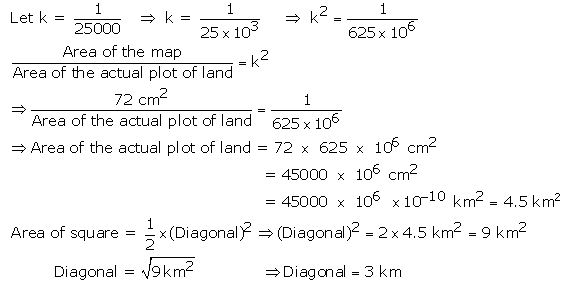
Question 22 The model of a building is constructed with the scale factor 1 : 30.
(i) If the height of the model is 80 cm, find the actual height of the building in metres.
(ii) If the actual volume of a tank at the top of the building is 27 m³, find the volume of the tank on the top of the model. (2009)
Answer 22
The model of a building is constructed with the scale factor 1 : 30
So, Height of the model/Height of actual building = 1/30
(i) Given, the height of the model is 80 cm
Then, 80/H = 1/30
H = (80 × 30)
H = 2400 cm
H = 2400/100
H = 24 m
(ii) the actual volume of a tank at the top of the building is 27 m³
Volume of model/Volume of tank = (1/30)3
V/27 = 1/27000
V = 27/27000
V = 1/1000 m3
Hence, Volume of model = 1000 cm3
Question 23 A model of a ship is made to a scale of 1 : 200.
(i) If the length of the model is 4 m, find the length of the ship.
(ii) If the area of the deck of the ship is 160000 m², find the area of the deck of the model.
(iii) If the volume of the model is 200 litres, find the volume of the ship in m³.
(100 litres = m³)
Answer 23
Scale = 1 : 200
(i) Length of a model of ship = 4 m
Then, length of the ship = (4 × 200)/1
= 800 m
(ii) Given, the area of the deck of the ship is 160000 m²
Then, area of deck of the model = 160000 × (1/200)2
= 160000 × (1/40000)
= 4 m2
(iii) Given, the volume of the model is 200 liters
Then, Volume of ship = 200 × (200/1)3
= 200 × 8000000
= (200 × 8000000)/100
= 1600000 m3
— : End of ML Aggarwal Similarity Exe-13.3 Class 10 ICSE Maths Solutions : –
Return to :- ML Aggarwal Solutions for ICSE Class-10
Thanks
Please Share with Your Friends
